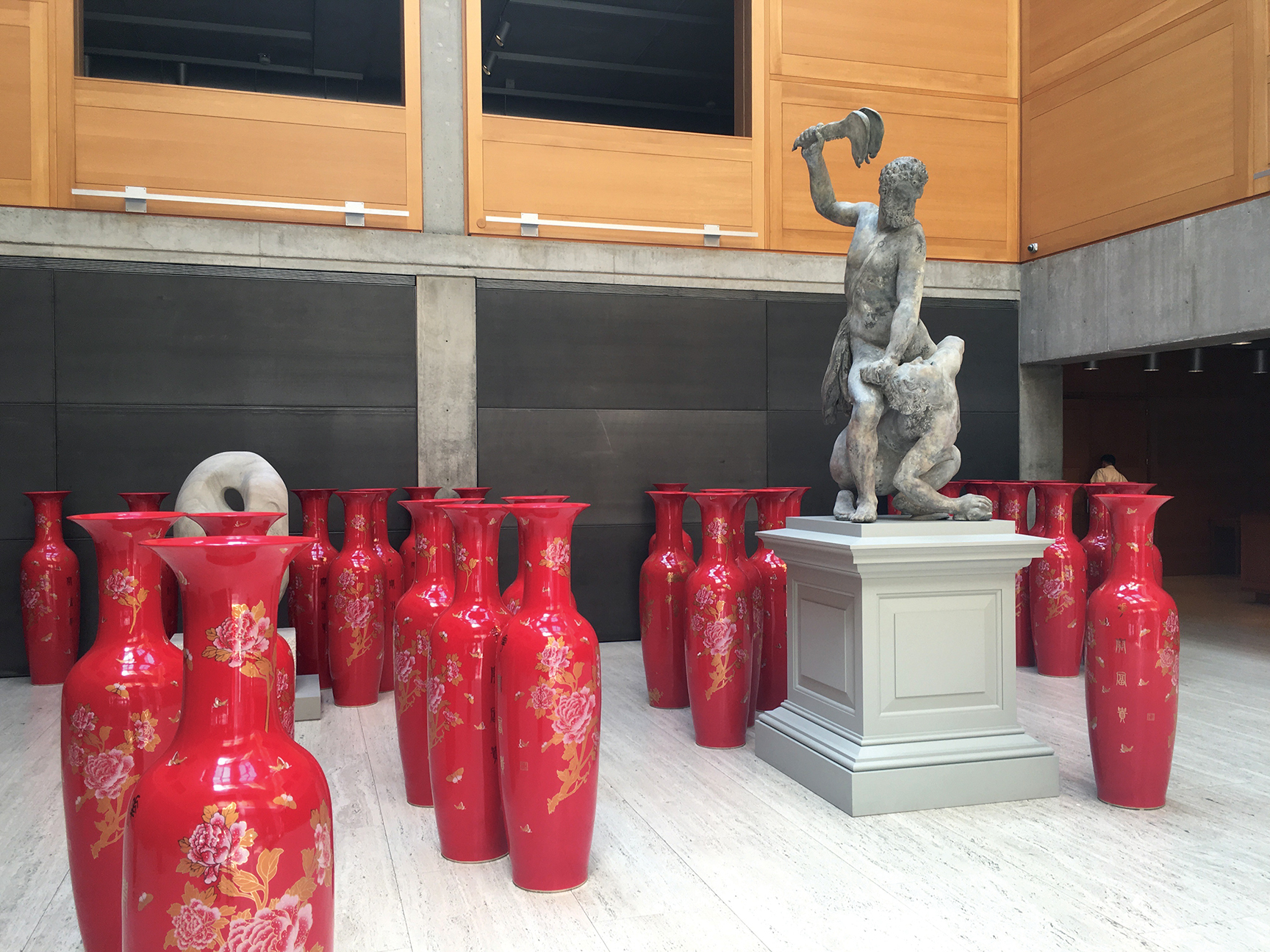
As you enter the Yale Center for British Art, the bright red vases of the new exhibit “Made in China” shimmer under the lobby’s natural light. The exhibit invites the viewer to wander through and inspect the nearly four-foot-high vases, 79 of which look quite similar to one another. These vases were produced in the Chinese city of Jingdezhen and are decorated with colorful large peonies, swallowtail butterflies and Chinese characters. From a distance, the designs look smooth and flawless, but up close there is evidence that they were printed out rather than hand-painted. The thin gold border around each design gives them an almost decal-like appearance.
But the exhibit is centered on the 80th vase, placed behind a large sculpture in a cluster of other vases. This vase, of the same height and shape as the others, was produced in Britain rather than China, and cost more to produce than the other 79 combined. It is covered in images of branches, butterflies, flowers and birds, and unlike the Chinese-produced vases there is no color, only fine gold. This vase features much more intricate detail, though the designs still appear to be laminated on.
The designs on the British vase have an anachronistic feel, looking much more like those from the 17th century than the 21st. And these designs, unlike the Chinese ones, lack scientific accuracy — lotus flowers are paired with vine leaves, and butterfly bodies are so disproportionate that they could never fly in real life.
While the vases are certainly beautiful, the exhibit’s commentary is anything but. The name of the exhibit, combined with the artist’s British heritage, cast the makers of the majority of the vases in an unsavory light. Clare Twomey, the artist, did not make any of the 80 vases. So it is her hand that we see not in the vases themselves, but in how they are positioned: 79 Chinese vases surrounding one British vase.
The information sheet gives little insight into how the artist wishes the exhibit to be interpreted, but it claims that the exhibit presents a “portrait of the international ceramic industry … that speaks not only to economic reality but also to cultural stereotypes concerning originality and craft.” Yet there is no commentary on or examination of these cultural stereotypes; instead, they are presented at face value. Chinese goods are mass-produced and low quality, and British goods are handmade and valuable. This also fails to consider the rich history of ceramic art in China, which has always included highly detailed and artisanal pieces, making the choice to focus on British artisans seem more based in stereotype than historical fact.
And the implications of these stereotypes echo outside of the art world. Westerners often claim that Asian Americans (and I assume Asian Brits) are identical or hard to tell apart, and this seems to be echoed by the exhibit’s 79 identical Chinese vases. Meanwhile, Western items are held up as exceptional and unique. The informational blurb also comments on the “few opportunities for individual creativity” offered by the Chinese ceramics manufacturing process, drawing on and reinforcing another pervasive stereotype, that Asian people lack creativity.
The exhibit also seems to play right into often racist anxieties about the decline of manufacturing in wealthy Western countries and a fear of jobs being outsourced to foreigners, especially nonwhite foreigners. But nothing is said about the poor working conditions faced by many factory laborers abroad, and Twomey presents the results as art without considering the wildly differing situations of the Chinese and British craftspeople.
Although the exhibit is undoubtedly beautiful, its reliance on tired stereotypes weakens its impact. “Made in China” could have benefited from a deeper examination of the ideology around which it is constructed. The exhibit is on view at the Yale Center for British Art until Dec. 3.
Peter Chung | peter.chung@yale.edu | @chungfish
Katie Martin | katherine.d.martin@yale.edu | @katdmartin







